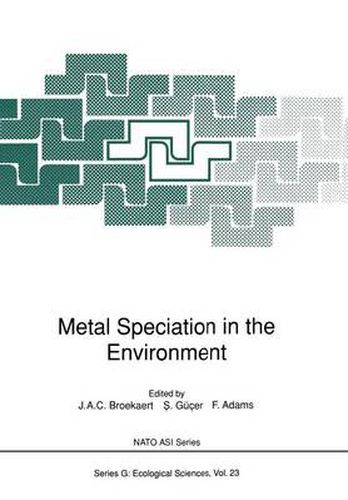Readings Newsletter
Become a Readings Member to make your shopping experience even easier.
Sign in or sign up for free!
You’re not far away from qualifying for FREE standard shipping within Australia
You’ve qualified for FREE standard shipping within Australia
The cart is loading…






This title is printed to order. This book may have been self-published. If so, we cannot guarantee the quality of the content. In the main most books will have gone through the editing process however some may not. We therefore suggest that you be aware of this before ordering this book. If in doubt check either the author or publisher’s details as we are unable to accept any returns unless they are faulty. Please contact us if you have any questions.
Metal Speciation in the Environment is a multidiscipliary treatment of the occurrence, mobility and detection of metal compounds within different environments as well as their interaction with life. Special emphasis is given to the complexation of metals, to the state of the art of trace analytical methodology available for metal speciation (including atomic absorption spectrometry, plasma emission and mass spectrometry, neutron activation analysis, electrochemical methods, chemical sen- soring, a.o.), and environmental chemistry of elements such as the actinides and heavy metals (e.g. chromium, arsenic, tin, and copper).
$9.00 standard shipping within Australia
FREE standard shipping within Australia for orders over $100.00
Express & International shipping calculated at checkout
This title is printed to order. This book may have been self-published. If so, we cannot guarantee the quality of the content. In the main most books will have gone through the editing process however some may not. We therefore suggest that you be aware of this before ordering this book. If in doubt check either the author or publisher’s details as we are unable to accept any returns unless they are faulty. Please contact us if you have any questions.
Metal Speciation in the Environment is a multidiscipliary treatment of the occurrence, mobility and detection of metal compounds within different environments as well as their interaction with life. Special emphasis is given to the complexation of metals, to the state of the art of trace analytical methodology available for metal speciation (including atomic absorption spectrometry, plasma emission and mass spectrometry, neutron activation analysis, electrochemical methods, chemical sen- soring, a.o.), and environmental chemistry of elements such as the actinides and heavy metals (e.g. chromium, arsenic, tin, and copper).